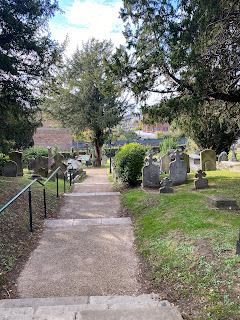"The oldest church in continuous use in the English speaking world; part Roman, part Saxon."
The Church of St Martin is an ancient church just beyond Canterbury city centre. It is generally recognised as the oldest church building in Britain still in use as a church and the oldest existing parish church in the English speaking world. The church is part of a World Heritage site with Canterbury Cathedral and St. Augustine’s Abbey.
The oldest part of St Martin’s church was built during the Roman occupation of Britain. It is uncertain whether at first the building was a church, a mausoleum, or something else.
Bertha was a Christian princess from Tours, in France. About AD580 she married Ethelbert of Kent, who was a pagan Anglo Saxon. Ethelbert restored St Martin’s for her, and she prayed here regularly. Ethelbert became king of Kent and ‘over-king’ of all the kingdoms northwards to the River Humber (200 miles to the north).
Augustine was a Benedictine monk in Rome. He arrived here in AD597 with 40 companions, including Roman monks and Frankish interpreters, to preach the good news of Jesus Christ. St Martin’s was Augustine’s first base for his mission. 'Here they first began to assemble, to sing the psalms, to pray, to celebrate mass, to preach and to baptize, until the king was converted to the faith and gave them greater freedom to preach and to build and restore churches everywhere'. (Bede’s Ecclesiastical History, AD731).
Bede writes of the enormous impact made by the message of Jesus, by the holy lives of the monks, and by miracles which confirmed the message. 'Great numbers gathered each day to hear the word of God, forsaking their heathen rites and entering the unity of Christ’s holy church as believers'. Pope Gregory, who had sent Augustine from Rome, wrote to Augustine telling him not to become swollen-headed because of the extraordinary things that God had chosen to do through him.
Needing more space, they extended St Martin’s to nearly its present size, using Roman building methods and reusing some Roman bricks. The largest part of the building (the nave) was the first Anglo Saxon structure made of mortared brick and stone instead of wood. Ethelbert soon granted Augustine more land in Canterbury, where he founded the Abbey and the Cathedral. Augustine became the first Archbishop of Canterbury. He died in AD 604 and was buried in the Abbey.
The east end of St Martin’s church was extended in the 12-13th centuries and substantially altered in the 19th century. The church tower was added in the 14th century. It has three bells, the largest of which was made in 1393.
St Martin’s remains in use for Christian worship, prayer and mission, as it has done ever since Augustine arrived in the 6th century.
Standing at the door it is almost a straight line to Canterbury Cathderal.
The grave of Herbert Bird Tourtel (1874-1931) and his wife Mary Tourtel (1874-1948) who is best remembered for creating Rupert The Bear.
The north windows depict women who helped spread the faith, including Queen Bertha and her daughter Ethelburga who converted Kimg Edwin of Northumbria and founded an abbey at Lyminge.
Unity window - The design by Nicola Kantorowicz symbolizes Jesus’ prayer for the unity of his followers (John 17). Installed 1995 in memory of Lt-Col John Haddon, an energetic supporter of St Martin's and of Christian unity.
The St. Martin’s chrismatory. This is a replica of the 14th Century copper alloy chrismatory found in 1849 in the nave. Chrismatories originate from English churches in the 13th Century. They are containers for the three holy oils; oil of the catechumems (used at baptism); oil of the sick; and chrism, a mixture of olive oil and balsam used for confirmation and ordination and from which the name was derived. The use of special oils for liturgical functions such as consecration of priests and kings was familiar from Old Testament times, and was adopted by the early church. In the reign of Elizabeth I (1533-1603) the elimination of base metal church plate formed part of the campaign against superstition, and almost all of it went into the melting pot - it is likely the original chrismatory was hidden for safe keeping.
Statue of Queen Bertha by Mother Concordia of Minster Abbey (1997)
This tomb was thought to be the resting place of Queen Bertha. It was broken into in the 19th Century and found to contain the bones of an old man, possibly a hunchback. It is thought he may have funded some works or building of the church. The plaque bears a Latin inscription which reads “If by chance near here rest the remains of Bertha, wife of King Ethelbert, let them rest in peace until the last coming of the Lord Jesus.” Bertha is buried at St. Augustine’s Abbey or under the step of St. Martin’s church depending on what you believe. Update: it is suggested that this tomb belongs to Thomas Stoughton (1537-1591) also known as Thomas Stockton said to be the great great grandson of Sir John Stockton, Lord Mayor of London.
























No comments:
Post a Comment